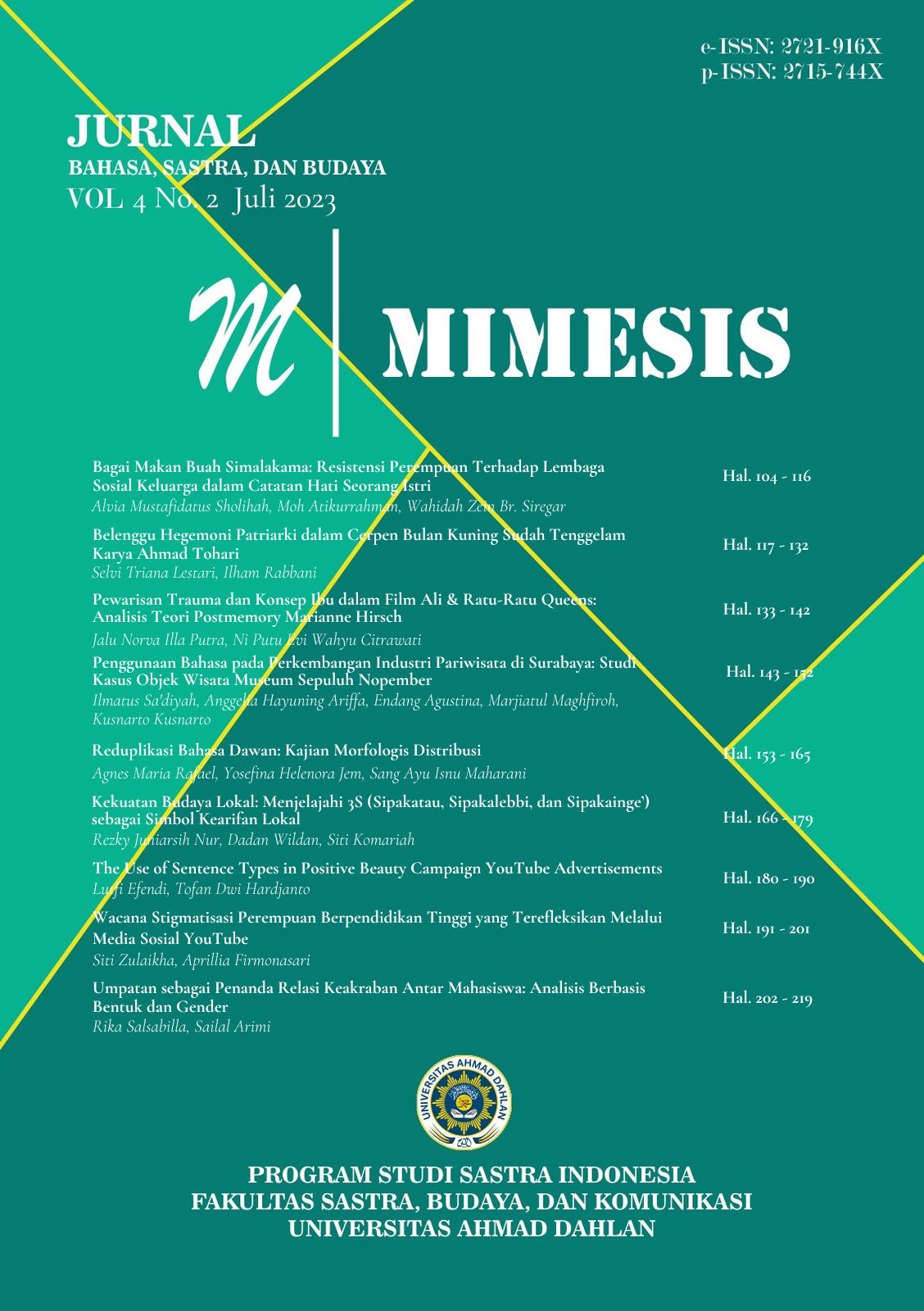The Use of Sentence Types in Positive Beauty Campaign YouTube Advertisements
DOI:
https://doi.org/10.12928/mms.v4i2.8250Keywords:
Positive Beauty Campaigns, Sentence Types, Social Media, YouTube AdvertisementsAbstract
Beauty products use social media to advertise their products to get people to know them. To attract the audience, the advertisers need to reflect the sentence types as well as the titles as the marketing approach. Understanding the sentence types essential for the company to reach the targeted market. This research studied the sentence types of positive beauty campaign YouTube advertisements. The data collecting technique is through document review by using converted spoken utterances from the positive beauty campaign YouTube advertisement videos. The encrypted videos are from Pantene Pro-V It’s time we see grey hair differently #PowerOfGrey, NEW Rare Beauty by Selena Gomez, Unilever Positive Beauty, and Dove Beauty on your own term #MyBeautyMySay. The results showed that declarative sentences are the most widely used in advertisements. Through declarative sentences, the advertisers persuade the audience to have a look at the message of the positive beauty campaign. Also, the purpose of a positive beauty campaign is to spread and embrace a positive awareness of beauty, therefore the role of the sentence type is significant to support the message of the advertisement.
References
Aarts, B. (2001). English Syntax and Argumentation: Second Edition. London: Palgrave.
Alasuutari, P. (1995). Researching culture: Qualitative method and cultural studies. London: Publication Ltd.
Banet-Weiser, S. (2017). ‘I’m Beautiful the Way I Am’: Empowerment, Beauty, and Aesthetic Labour. In A. S. Elias, R. Gill, & C. Scharff (Eds.), Aesthetic Labour (pp. 265–282). Palgrave Macmillan UK. https://doi.org/10.1057/978-1-137-47765-1_15
Berger, A.A. (2012). Media, Myth, and Society. New York: Palgrave Macmillan.
Chen, J.-L., & Dermawan, A. (2020). The Influence of YouTube Beauty Vloggers on Indonesian Consumers’ Purchase Intention of Local Cosmetic Products. International Journal of Business and Management, 15(5), 100. https://doi.org/10.5539/ijbm.v15n5p100
Kaur, et al. (2013). Beauty Product Advertisement: A Critical Discourse. Asian Social Discourse. http://dx.doi.org/10.5539/ass.v9n3p61.
Grimaldi, et al. (2003). Inside the minds: The art of advertising: CEOs from BBDO, Mullin advertising & more on generating creative campaigns & building successful brands. Aspatore Books.
Hidayah, R. & Milal, A.D. (2006). Ideal Identity Construction in Beauty Product Advertisement of Garnier. Journal of Literature and Language Teaching. https://doi.org/10.15642/NOBEL.2016.7.2.120-136.
Huddleston, R. (1984). Introduction to the Grammar of English. New York: Cambridge University Press.
Joshi, M. (2014). Simple, Compound, Complex, and Compound-Complex Sentences: English Sentence Forms. South Carolina: Createspace Independent Publishing Platform.
Kelley, L.D. et al. (2015). Advertising Media Planning: A Brand Management Approach. New York: Routledge.
Linghong, Z. (2006). The linguistic features of English advertising. Ce lea Journal, 29(1), 71-78.
Miller, M. (2011). YouTube for business online video marketing for any business. Indiana: Que Publishing.
Moleong, L.J. (2010). Metodologi Penelitian Kualitatif. Bandung: Remaja Rosda Karya.
Radford, A. (2009). Analysing English Sentences: A Minimal Approach. New York: Cambridge University Press.
Sembiring, et al. (2020). Language Characteristics of Beauty Product Advertisements. Linguistik Terapan. https://doi.org/10.24114/lt.v17i1.19769.
Quesenberry, K.A. (2019). Social Media Strategy: Marketing, Advertising, and Public Relations in the Consumer Revolution. London: Rowman & Littlefield.
Downloads
Published
Issue
Section
License
Copyright (c) 2023 Lutfi Efendi, Tofan Dwi Hardjanto

This work is licensed under a Creative Commons Attribution-ShareAlike 4.0 International License.
License and Copyright Agreement
In submitting the manuscript to the journal, the authors certify that:
- They are authorized by their co-authors to enter into these arrangements.
- The work described has not been formally published before, except in the form of an abstract or as part of a published lecture, review, thesis, or overlay journal.
- That it is not under consideration for publication elsewhere,
- That its publication has been approved by all the author(s) and by the responsible authorities tacitly or explicitly of the institutes where the work has been carried out.
- They secure the right to reproduce any material that has already been published or copyrighted elsewhere.
- They agree to the following license and copyright agreement.
Copyright
Authors who publish with Mimesis agree to the following terms:
- Authors retain copyright and grant the journal right of first publication with the work simultaneously licensed under a Creative Commons Attribution License (CC BY-SA 4.0) that allows others to share the work with an acknowledgment of the work's authorship and initial publication in this journal.
- Authors are able to enter into separate, additional contractual arrangements for the non-exclusive distribution of the journal's published version of the work (e.g., post it to an institutional repository or publish it in a book), with an acknowledgment of its initial publication in this journal.
- Authors are permitted and encouraged to post their work online (e.g., in institutional repositories or on their website) prior to and during the submission process, as it can lead to productive exchanges, as well as earlier and greater citation of published work.











